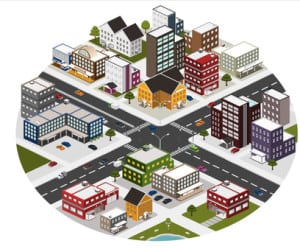
Honeywell Building Solutions used Microsoft’s Azure platform to enable preemptive maintenance and streaming analytics for building equipment such as HVAC.
Name of Organization: Honeywell Building Solutions
Industry: Manufacturing
Location: Golden Valley, MN USA
Business Opportunity or Challenge Encountered:
Honeywell Building Solutions installs and manages integrated building control systems, including heating and cooling, lighting, safety, and security systems for thousands of commercial, municipal, and industrial facilities, including apartment buildings, shopping centers, and airports. The company tracks the condition and performance of its building management equipment over time with on-site sensors that capture and record up-to-the-minute information.
The company collects and processes real-time performance information from the equipment that regulates air quality and temperature in the facilities it services. The company can monitor conditions, preempt maintenance, and save its global customers energy, time, and money.
In 2014, Honeywell began connecting its vast systems of devices to an Internet of Things (IoT) platform so they could autonomously send data to remote monitors in the cloud. The company needed a system that could transform the collected data into useful and timely information on which its customers could readily act. If engineers could predict when a filter on an air-handling unit needed to be replaced, for example, instead of replacing it on a fixed schedule regardless of need, it could save the customer not only the cost of the filter but also the shipping and installation costs. Honeywell knew that this kind of preventative maintenance could also potentially extend the life of that unit by 10 or even 15 months. Multiplying these savings over the thousands of assets it services across hundreds of buildings would mean that Honeywell could offer its customers significant savings.
“Each remote sensor collects 20 to 40 distinct data points related to room temperature and humidity from each of the various units across a building,” says Ashley Noble, engineering fellow at Honeywell. The company needed a quicker, more reliable, and more scalable way to process and analyze the data, “Once we started lifting the data off-site, we tried using homegrown techniques, which let us analyze it only every 12 or 24 hours,” Noble says. “This did not meet some of our customers’ needs.” Honeywell customers needed to know how buildings were functioning in real time.”
How This Business Opportunity or Challenge Was Met:
Honeywell implemented Microsoft’s Azure cloud platform, which enabled engineers to configure a data-processing environment capable of ingesting thousands of events as they happened. The system compared those streams to models configured to reflect optimal operating conditions so they could detect errant behavior that would signify equipment failure, substandard performance, or disrepair.
Honeywell’s engineers programmed each of the sensors in the field to send a stream of messages every minute describing the changes occurring in the equipment, building, and configuration state to the IoT platform. Azure Table Storage stores the telemetry data. Stream Analytics then identifies certain building-specific equipment behavior as fault-state behavior and tags it as an anomaly. When a specific error or condition appears in the incoming streams of data, the notification engine sends an alert to the customer via a customized dashboard.
Measurable/Quantifiable and “Soft” Benefits from This Initiative:
Honeywell reports that it was able to begin generating results in Stream Analytics almost immediately. Once it has captured the data, Honeywell can use Stream Analytics to write very small formulas to detect whether building equipment performance is trending in a negative direction or failing. Set-up takes about 10 minutes, Honeywell engineers estimate.
As a result, Honeywell can deliver actionable insight, identify trends as they emerge, and respond more quickly to customers’ needs, who can respond more quickly to the equipment fault or maintenance need in the short term and make data-driven business decisions for facility health in the long term.
“We’ve identified 200 to 300 analytics we want to run that will actually inform the business of managing buildings,” says Noble. With the data streaming from these sensors, Honeywell can alert users to critical equipment faults, energy saving opportunities, and repair incidents. “We have been able to build the system to notify a facility manager if lighting is off schedule or if CO2 levels are off the mark.”
The built-in system of alerts, which notify the right team or department in the business when repair or maintenance is needed, enables Honeywell to innovate, improve, and add to its service offerings. “Our customers stand to save a significant amount of energy and money when they get early maintenance feedback saying the filters need changing on a certain air-handling unit,” says Noble.
(Source: Microsoft)
Want more? Check out our most-read content:
White Paper: How to ‘Future-Proof’ a Streaming Analytics Platform
Research from Gartner: Real-Time Analytics with the Internet of Things
E-Book: How to Move to a Fast Data Architecture
The Value of Bringing Analytics to the Edge
IoT Interoperability: An Internet of Broken Things
Finding Business Value in IoT Services
Liked this article? Share it with your colleagues!






























